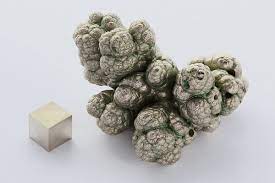Nickel
Nickel is a metallic element with a silvery-white, shiny appearance. It is the fifth-most common element on earth and occurs extensively in the earth's crust and core. Nickel, along with iron, is also a common element in meteorites.
Nickel is used in batteries, including rechargeable nickel-cadmium batteries and nickel-metal hydride batteries used in hybrid vehicles.

